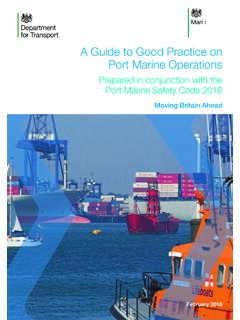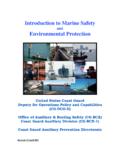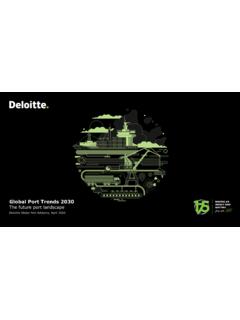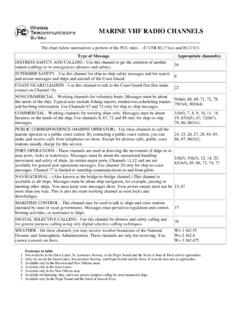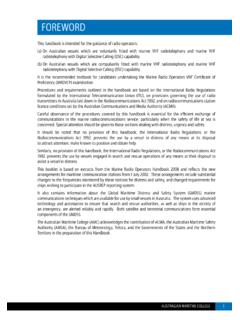Transcription of Port Marine Safety Code - GOV.UK
1 Port Marine Safety Code For all UK Harbour Authorities and other Marine facilities, berths and terminals Moving Britain Ahead November 2016 Foreword The UK ports industry, by virtue of our long coastline and maritime history, is the largest in Europe and so the UK very much depends on its ports and terminals for trade. Approximately 95 per cent of the volume of all UK import/export trade enters the UK through its ports making a contribution of around billion to the UK economy. Given the significance and importance of our ports , it is crucial that we treasure and protect our industry.
2 Both Government and industry play a vital role in ensuring that we remain committed to continuously improving the standards of Safety in our sector and maintaining the vigorous Safety record of our ports and harbours. This Code, and the associated Guide to Good Practice, play an instrumental role in achieving this by providing a pragmatic and proportionate approach to Safety standards which enable everyone who is involved, from major ports to smaller Marine terminals and harbours, to proportionately apply the principles upon which it is based.
3 It is strongly recommended that organisations or facilities which are not a statutory harbour authority, including berths, terminals and marinas, seek to comply with this Code through the adoption of a Marine Safety management system or any alternative similar standard applicable to their sector (such as that for marinas) and underpin this with a formal risk assessment process. The Government continues to support this non-mandated Code as the most effective and efficient way of maintaining and promoting nationally recognised Safety standards for the port Marine industry.
4 The Rt Hon John Hayes CBE MPMinister of State for Transport 1 1 Contents Ministers Foreword What does the Port Marine Safety Code mean for Harbours, Marine Facilities,Berths and Terminals 4 Executive summary 6 Introduction 9 The Port Marine Safety Code 13 Contents 14 1. Accountability for Marine Safety 17 Duties and Powers 17 The Duty holder 18 The Designated Person 19 Chief Executive or equivalent 19 Harbour Master 20 The organisation s officers 20 2. Key measures to secure Marine Safety 21 Review existing powers 21 Use formal risk assessment 22 Implement a Marine Safety Management System 23 Competence standards 24 Incident reporting and investigation 24 Monitoring performance and auditing 24 25 Publication of plans and reports Enforcement 25 Consensus 25 Monitoring compliance 25 2 Port Marine Safety Code 3.
5 General Duties and Powers 27 Safe and efficient port Marine operations 27 Open port duty 28 Conservancy duty 28 Environmental duty 29 Civil contingencies duty 29 Harbour authority powers 29 Revising duties and powers 29 4. Specific Duties and Powers 31 Appointment of harbour master 31 Byelaws 31 Directions (usually referred to as Special Directions) 32 General Directions and Harbour Directions 32 Dangerous Vessel Directions 32 Pilotage and Pilotage Directions 33 Authorisation of Pilots 33 Pilot Exemption Certificates 33 Collecting dues 33 Aids to Navigation 34 Wrecks and Abandoned Vessels 35 3 t W D ^ LJ D & Duty holder Formally iden LJ and designate the duty holder.
6 Whose members are individually and colle vely accountable or compliance with the Code and their per ormance in ensuring s e Marine opera ons in the harbour and its approaches. Designated Person A designated person must be appointed to provide independent assurance about the opera on o the Marine sa ty management system. The designated person must have direct access to the duty holder. Legisla The duty holder must review and be d Du es and Powers Comply with the du s and d Risk Assessment LJ assessed and are eliminated or reduced as low as reasonably Marine Safety Management System K LJ
7 Review and Audit D LJ LJ LJ LJ Competence Use competent people (who are d LJ LJ Plan W LJ standards in the Code will be met and a report least every three years.)
8 Aids to Naviga on LJ ' > LJ Port Marine Safety Code Port Marine Safety Code 45 Executive summary What is the Port Marine Safety Code? 1. The Port Marine Safety Code ( the Code ) sets out a national standard for every aspect of port Marine Safety . Its aim is to enhance Safety for everyone who uses or works in the UK port Marine environment. It is endorsed by the UK Government, the devolved administrations and representatives from across the maritime sector and, while the Code is not mandatory, these bodies have a strong expectation that all harbour authorities will comply.
9 The Code is intended to be flexible enough that any size or type of harbour or Marine facility will be able to apply its principles in a way that is appropriate and proportionate to local requirements. Who is the Code for? 2. The Code is applicable both to statutory harbour authorities and to other Marine facilitieswhich may not have statutory powers and duties. These are collectively referred to throughout the Code as organisations and may include, but are not limited to, the following:Competent Harbour Authorities (authorities with statutory pilotage duties);Municipal Port or Harbour Authorities;Trust Port or Harbour Authorities;Private Port or Harbour Authorities; andMarine berths, terminals or jetties.
10 3. It is strongly recommended that organisations or facilities which are not a statutory harbour authority, such as Marine berths and terminals, seek a proportionate compliance with this Code through the adoption of a formal risk assessment process and the implementation of a Marine Safety management system ( MSMS ) which complies withthis Code or any alternative similar standard applicable to their sector. 4. Where a Marine terminal or jetty is situated within the jurisdiction of a Statutory Harbour Area ( SHA ), it is important for both parties to engage with one another to ascertain the scope and extent of the SHA s MSMS and whether it incorporates any of the terminal s or jetty s Marine operations.










